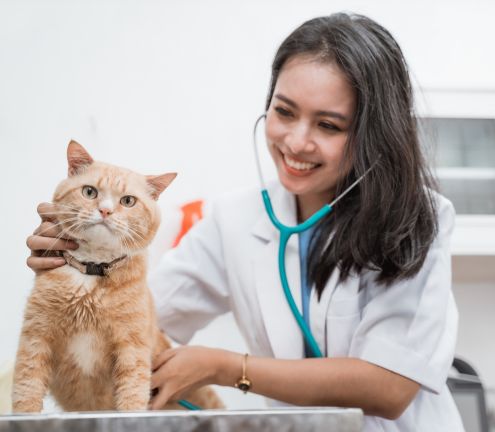Parvo in cats, also known as feline panleukopenia or feline parvovirus, is a highly contagious and life-threatening disease. This virus primarily affects kittens and unvaccinated cats, attacking their immune system and rapidly dividing cells.
Unlike parvovirus in cats, which is specific to felines, canine parvovirus affects dogs, though both share similarities in symptoms and transmission. Understanding the parvo symptoms, early detection, and prevention strategies can help protect your cat from this deadly disease.
What is Feline Panleukopenia?
Feline panleukopenia, also referred to as parvovirus in cats, is caused by a virus that destroys white blood cells, weakens the immune system, and leads to severe gastrointestinal and neurological issues. The disease spreads rapidly and has a high mortality rate, especially in kittens. Unlike early symptoms of parvo in puppies, which primarily affect the intestines, feline panleukopenia can also cause brain damage in unborn kittens if the mother is infected during pregnancy.
How is Feline Parvovirus Transmitted?
Feline parvovirus spreads through direct contact with an infected cat’s bodily fluids, feces, or vomit, as well as contaminated surfaces like food bowls, litter boxes, and human hands. The virus is highly resilient, surviving for months in the environment. Kittens can also get infected in the womb if the mother carries the virus. Vaccination and strict hygiene are key to preventing its spread.
Parvo Symptoms in Cats
The parvo symptoms in cats can appear suddenly and worsen quickly, requiring immediate attention.
Gastrointestinal Symptoms
- Severe vomiting – Continuous vomiting leads to dehydration and weakness.
- Diarrhea (often with blood) – Intestinal damage causing fluid loss and further dehydration.
- Loss of appetite – Refusal to eat due to nausea and stomach discomfort.
- Dehydration – Loss of fluids, leading to dry gums, sunken eyes, and weakness.
Behavioral and Physical Changes
- Extreme lethargy – Lack of energy and unwillingness to move or play.
- Weakness and reluctance to move – Muscle fatigue makes movement difficult.
- Hiding behavior – Withdrawal from social interaction due to illness.
- Fever and Immune System Suppression
- High fever followed by a drop in body temperature – Early fever that later turns into hypothermia.
- Low white blood cell count – Weak immune response making the cat prone to infections.
- Susceptibility to secondary infections – Increased risk of bacterial and viral illnesses due to immune suppression.
Neurological Symptoms (in Kittens)
- Tremors – Involuntary shaking due to nervous system damage.
- Lack of coordination – Difficulty walking or balancing caused by brain development issues.
- Stunted growth (if infected in the womb) – Improper physical and neurological development in affected kittens.
Recognizing early symptoms of parvo in puppies is different from feline parvovirus, as the latter can also impact brain development in young kittens.
Diagnosis of Feline Panleukopenia
Feline panleukopenia is diagnosed through clinical signs, blood tests, and fecal testing. Vets check for a low white blood cell count, a key indicator, and use PCR or ELISA tests to detect the virus in feces. Feline panleukopenia has a mortality rate of up to 90% in untreated cases, making early diagnosis crucial for survival.
Treatment for Parvo in Cats
There is no direct antiviral cure for feline panleukopenia, so treatment focuses on supportive care to help the cat recover.
- Hospitalization and Intensive Care
- IV Fluids and Electrolytes – Prevent dehydration and maintain organ function.
- Nutritional Support – Special feeding methods if the cat refuses to eat.
- Medications
- Antibiotics – To prevent bacterial infections due to a weakened immune system.
- Anti-nausea Drugs – To control vomiting.
- Isolation and Hygiene
- Infected cats should be quarantined to prevent virus spread.
- Surfaces should be disinfected with bleach-based cleaners, as standard disinfectants may not be effective.
Survival rates depend on early detection and supportive care. Kittens over two months have up to a 70% survival rate with treatment but nearly 100% mortality without it. Adult cats face a 10-20% risk when treated, rising to 85% if untreated, while elderly cats have a 20-30% mortality rate with care and 90% without.
How to Protect Your Cat from Parvo?
According to European Journal of Veterinary, you need to follow the following ways to protect your cat from Parvo:
- Ensure they receive timely vaccinations, as this is the most effective prevention.
- Keep their environment clean by disinfecting food bowls, litter boxes, and bedding.
- Avoid contact with infected cats and quarantine new pets before introducing them.
- Regular vet check-ups help detect any early signs of infection.
Follow the vaccination to prevent Parvo in cats
| Cat’s Age | Vaccination Dose | Booster schedule |
| 6-8 weeks | First dose of FCP vaccine | Every 3-4 weeks until 16-10 weeks old |
| 16-20 weeks | Final kitten booster | 1 year booster after the last dose |
| 1 year | Booster shot | Every 1-3 years, as per vet’s advice |
Feline Panleukopenia vs. Canine Parvovirus
Many pet owners ask if cats can get parvo from dogs. While both diseases are caused by parvoviruses, feline panleukopenia is specific to cats, and canine parvovirus affects dogs. However, the viruses are closely related, and both require strict prevention measures.
| Features | Feline Panleukopenia (FPV) | Canine Parvovirus (CPV) |
| Affected Species | Cats (especially kittens) | Dogs (especially puppies) |
| Virus Type | Feline parvovirus | Canine parvovirus (CPV-2, CPV-2a, CPV-2b, CPV-2c) |
| Transmission | Contact with infected feces, bodily fluids, contaminated surfaces | Direct contact, contaminated feces, environment |
| Symptoms | Vomiting, diarrhea, fever, lethargy, low white blood cell count | Vomiting, bloody diarrhea, fever, severe dehydration |
| Impact on Immune System | Destroys white blood cells, making cats vulnerable to infections | Damages intestinal lining and immune response |
| Neurological Effects | Can cause tremors and lack of coordination in kittens | No direct neurological impact |
| Survival in Environment | Can survive for months to a year on surfaces | Can survive for months in the environment |
| Prevention | Vaccination (FVRCP), strict hygiene | Vaccination, isolation of infected dogs |
FAQs
What are the early signs of feline parvovirus?
Early signs of feline parvovirus include lethargy, fever, loss of appetite, vomiting, and diarrhea, which may be bloody. Infected kittens may also show tremors or lack of coordination. Immediate veterinary care is crucial to improve survival chances.
Can indoor cats get parvo?
Yes, indoor cats can get parvovirus if exposed to contaminated objects, infected animals, or humans carrying the virus on their hands or clothes.
Can a vaccinated cat get parvo?
Vaccinated cats have a low risk of contracting parvo, but no vaccine is 100% effective. Regular booster shots help maintain strong immunity.
Conclusion
Parvo in cats is a deadly but preventable disease. Vaccination, early detection of parvo symptoms, and maintaining proper hygiene are essential to protecting your cat. If you suspect an infection, seek veterinary care immediately, as prompt treatment can improve survival chances.



